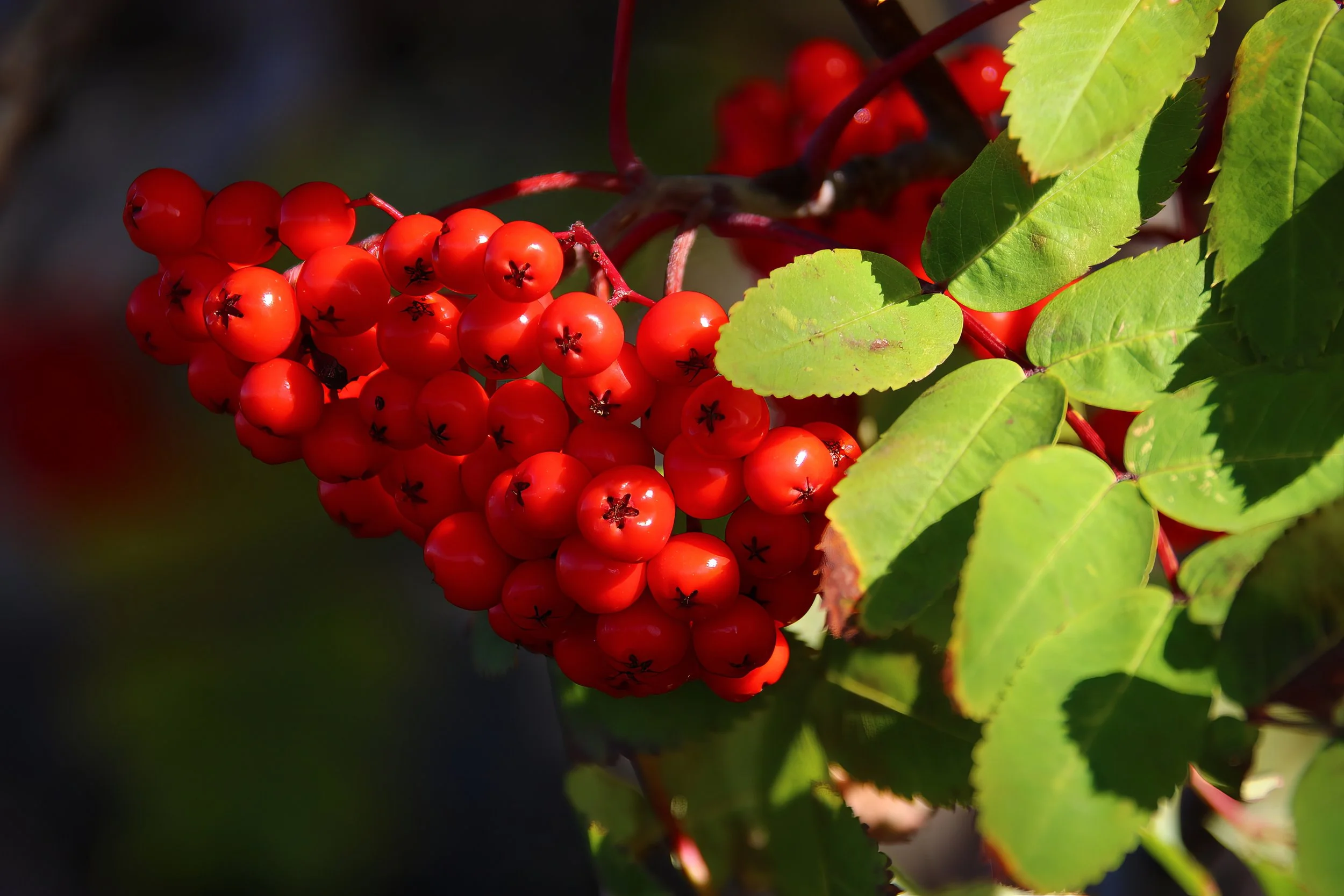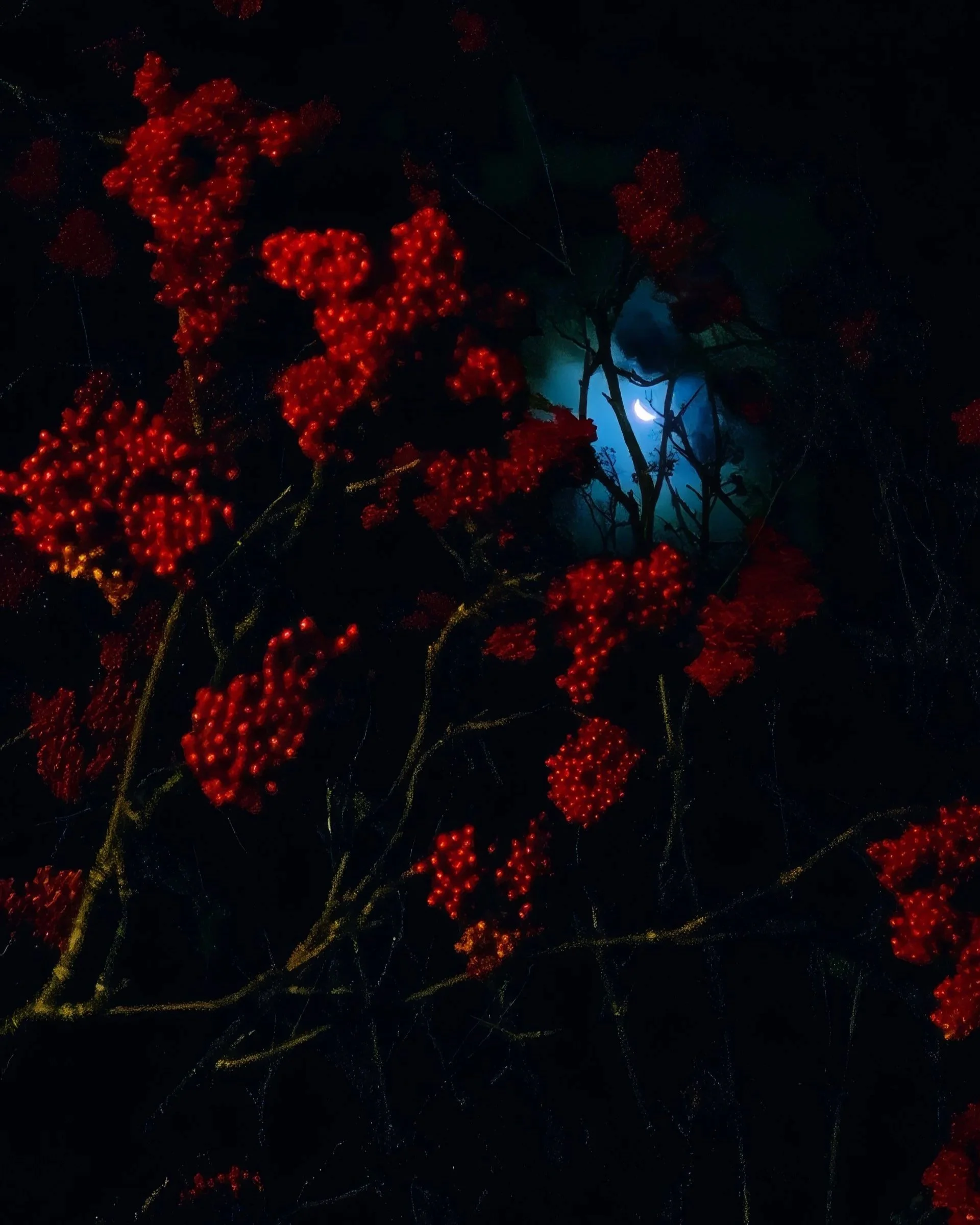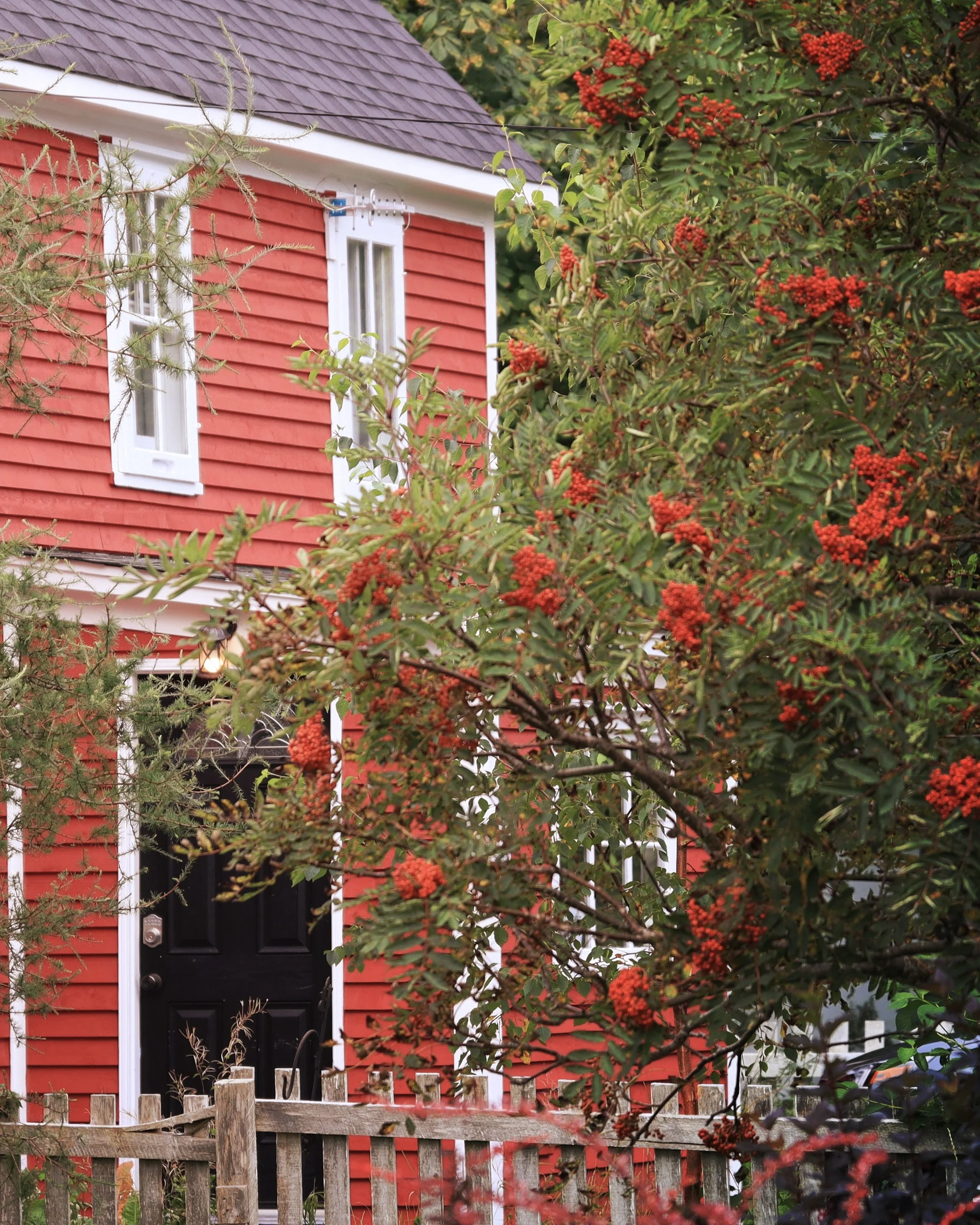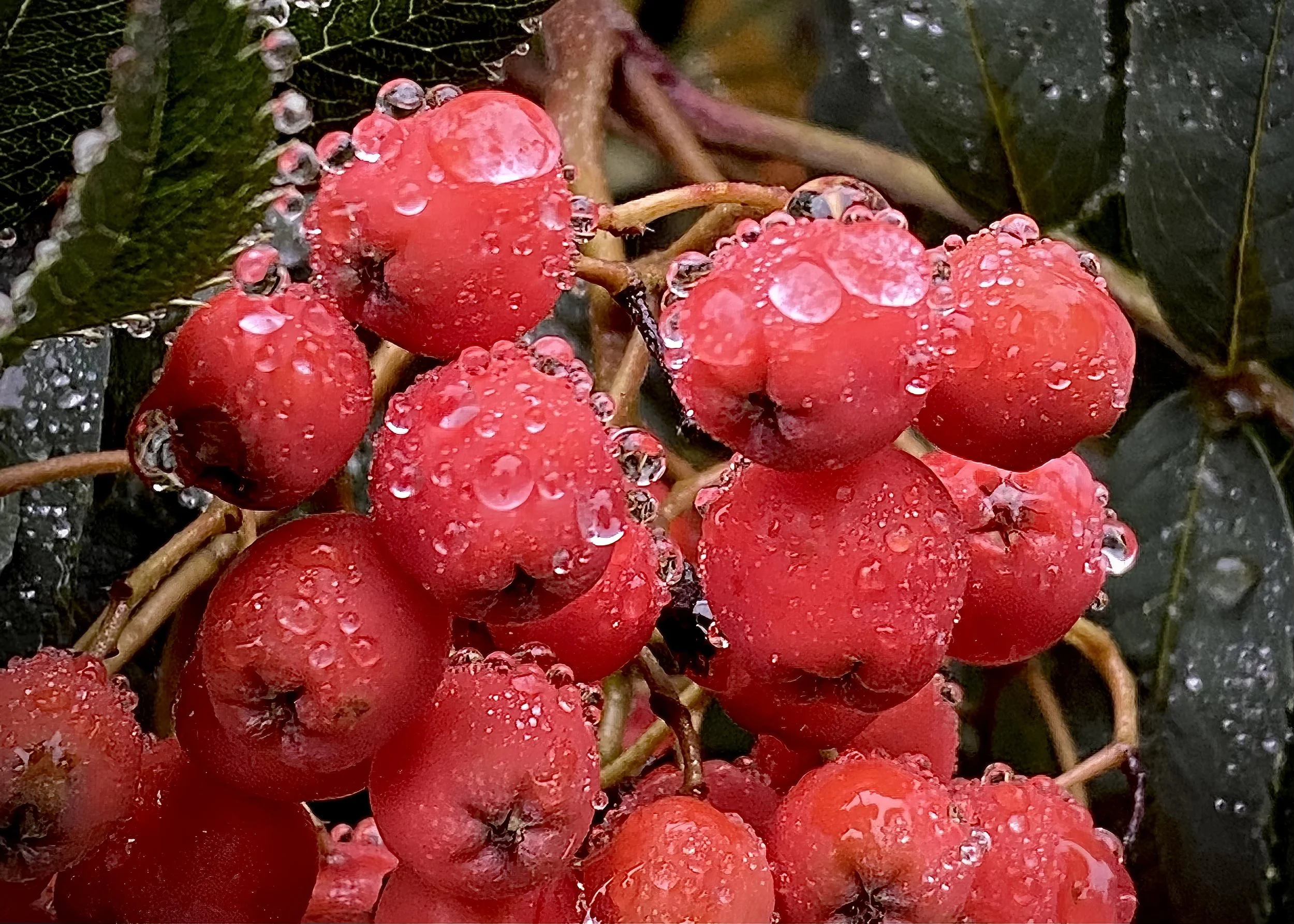The Tangled Lore of Dogberries
Dogberries in Gander, NL
Dogberry trees may be common in Newfoundland, but there’s nothing ordinary about them.
They burst into white blossom in spring, and by fall they glow with brilliant red-orange berries that manage to hang on well into the darkest days of winter. It’s no wonder they’ve worked their way into Newfoundland folklore — a tree as dramatic as the dogberry was bound to pick up a few stories along the way.
What is a dogberry tree?
A pine grosbeak (aka Mope) eating dogberries
It’s a rare Newfoundlander that won’t recognize a dogberry tree. It’s a deciduous tree that is common across Newfoundland, and many of the cool regions of the Northern Hemisphere. It’s a member of the genus Sorbus. Outside Newfoundland it is more commonly called the Mountain Ash or Rowen.
It’s easily recognizable by its compound, almost feather-shaped leaves and the large clusters of bright red berries it carries in the fall and winter. These berries make the tree a favourite stop for birds who appreciate the abundance of fresh fruit.
Newfoundlanders once appreciated the fruit of the dogberry, too.
Kitchens, Christmas and Cures
Thought it largely seems to have fallen out of favour, Newfoundlanders once included dogberries on the menu.
It may have been more a case of making do with what the land provided rather than a genuine appreciation for the fruit because,
by nearly all accounts, dogberries are not particularly palatable —or safe to eat — especially in their raw state. Many suggest the quality of berries varies by time and tree; it’s said they are better after the first frost and that not all trees are equal. Some dogberry trees produce better fruit than others.
I have never eaten dogberries but they are often described as astringent. On top of that they contain toxins. The toxins in the fruit are made safer for consumption by cooking but the seeds should not be eaten as they contain compounds that can turn to hydrogen cyanide during digestion. All recipes that include dogberries call for the removal of the seeds.
The two most common kitchen uses of dogberries were wine and jelly.
Dogberry wine was made with a mixture of dogberries, boiling water, and sugar or molasses. The concoction was left to ferment for a few weeks, strained and bottled.
Fresh snow on dogberries
It was a divisive drink. For some, it was a Christmas favourite, for others it was best reserved for use as a disinfectant, paint thinner, and rust remover.
Speaking of Christmas, it’s not hard to find references to Newfoundlanders using dogberries to bring festive colour to the Christmas season. They are an obvious choice — the bright red berries, which survive well into the winter season, make a perfect holiday companion for evergreen boughs.
Dogberry jelly was made with dogberries, sugar and often an additional fruit (many recipes I’ve read called for crabapples). Even with the sugar the jelly was still often described as bitter and seemed often to have been consumed as a condiment alongside meats.
If you’re curious, Bonita Hussey of Bonita’s Kitchen has a video demonstrating how she makes dogberry jelly. Her recipe includes ginger and oranges and sounds quite tasty.
Beyond the kitchen table, dogberries were relied upon as medication. It was believed that…
The stranger side of dogberries
Dogberries and moonlight
And while all of that is interesting, the real story of the dogberry tree is tangled up in superstition. From warnings of hard winters to tales of curses and magic, they are trees with their roots deep in the strange and the unusual.
Let’s start with a well-known superstition.
Weather
Most Newfoundlanders have probably heard it said that a bumper crop of dogberries foretells a hard winter to come. I’ve never been clear exactly what a hard winter means. I don’t know of that means especially snowy, unusually cold or insufferably long.
Perhaps it’s all three.
In any case, according to some storytellers the superstition comes from a faith in a benevolent universe — the idea that an abundance of berries is nature’s way of stocking the shelves, ensuring the birds have enough to survive a harsher-than-usual winter.
I don’t know. In my experience nature is neither that kind nor well-ordered.
I don’t think the superstition is backed by the evidence. I daresay the number of dogberries says a lot more about the weather during the growing season than it does about the conditions of the following winter.
It’s also worth noting that, for some, the superstition worked a little differently: few dogberries by winter meant a hard season ahead, as described by W. J. Caroll:
“Last year in October a couple of trees were bending down with dogberries. We intended cutting them for Christmas, but one day dozens of robins appeared and appropriated the fruit and we watched them clean up the berries from two or three trees. Next morning there was scarcely a berry left. It is said that the scarcity of dogberries denotes a hard winter. ”
The belief that dogberries can forecast the winter isn’t unique to Newfoundland. In Europe, the rowan (aka dogberry) tree was wrapped in weather lore and much more besides. It was said to shield homes from witches, protect livestock, and guard families from harm. When settlers came across the Atlantic, those old-world beliefs came with them, and the dogberry quickly grew into a tree of protection here too.
Protection
Dogberries in Trinity, NL
In Newfoundland the dogberry was seen as having the power to avert the ‘evil-eye’ and even stop disease.
One of my favourite superstitions involves passing a baby through a fork in the trunk of a dogberry tree. Doing so was thought to protect the child from measles, smallpox, croup, whooping-cough, and other childhood diseases. There is a tale of ‘Uncle Joe Tiller’s Dogberry’ in New-Wes-Valley that was considered especially potent. I’m not sure what made his tree better than the rest.
Dogberries didn’t have to be alive to be lucky. In an account from Bay St. George on the island’s west coast, mariners preferred boat tillers to be made of dogberry wood because it would bring safe travels to the boat.
Raindrops on Dogberries, Gander, NL
Water Witching
Not all dogberry magic was about protection. Back in the days when fresh water didn’t come from a tap, wells had to be dug — by hand. It was a tremendous amount of work and choosing where to dig could be tricky. You certainly didn’t want to get it wrong. To hedge their best some early Newfoundlanders relied on the expertise of a dowser, or “water witch.” These were people who claimed they could find underground water using a forked stick. — the stick of choice for many dowsers was the dogberry.
Respect the Tree
That said, one wanted to be careful in cutting dogberry trees. As reported in the Journal of American Folklore one nameless Newfoundland skipper said he’d never cut a young dogberry, to cut a maiden dogberry might mean making the ultimate sacrifice:
“I’d as lief cut my right hand off, as cut down a maiden dog-berry tree; a man is sure to die as does it.”
The Last Word on Dogberries
From warding off witches to protecting babies, from predicting winters to pointing the way to water, the dogberry tree has carried more superstition than pretty much any other plant in the Newfoundland forest.
And chances are, there are a lot more stories out there.
Newfoundland folklore grows as freely as dogberries, and I’d bet this tree has inspired plenty of other sayings, cures, and superstitions in coves all around the island. If you’ve heard one, I’d love to know — pass it along, and let’s see just how tangled the lore of the dogberry really is.
-
Edible Newfoundland Plants, Todd Boland
Do You Walk Under Ladders, The Log, vol. 14 no. 06, June 1952.
Animal and Plant Lore, Fanny D. Bergen, 1899
Digging In, Harold Horwood, Evening Telegram, Oct 24, 1962
Nothing to do with the Weather, Evening Telegram, Nov 11, 1915
Devine's Folk Lore of Newfoundland, P.K. Devine, 1937.
All Signs Point to Foul Weather, Sunday Herald, Oct 21, 1957.
Newfoundland, As It Was, and As It Is in 1877, P. Toque, 1878
The Osprey, Vol. 16, No. 3, 1985
Folklore of Wells in Newfoundland, Sarah Ingram, March 2014





